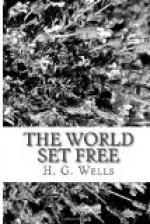It was in 1910 that the parents of young Holsten, who was to be called by a whole generation of scientific men, ’the greatest of European chemists,’ were staying in a villa near Santo Domenico, between Fiesole and Florence. He was then only fifteen, but he was already distinguished as a mathematician and possessed by a savage appetite to understand. He had been particularly attracted by the mystery of phosphorescence and its apparent unrelatedness to every other source of light. He was to tell afterwards in his reminiscences how he watched the fireflies drifting and glowing among the dark trees in the garden of the villa under the warm blue night sky of Italy; how he caught and kept them in cages, dissected them, first studying the general anatomy of insects very elaborately, and how he began to experiment with the effect of various gases and varying temperature upon their light. Then the chance present of a little scientific toy invented by Sir William Crookes, a toy called the spinthariscope, on which radium particles impinge upon sulphide of zinc and make it luminous, induced him to associate the two sets of phenomena. It was a happy association for his inquiries. It was a rare and fortunate thing, too, that any one with the mathematical gift should have been taken by these curiosities.
Section 8
And while the boy Holsten was mooning over his fireflies at Fiesole, a certain professor of physics named Rufus was giving a course of afternoon lectures upon Radium and Radio-Activity in Edinburgh. They were lectures that had attracted a very considerable amount of attention. He gave them in a small lecture-theatre that had become more and more congested as his course proceeded. At his concluding discussion it was crowded right up to the ceiling at the back, and there people were standing, standing without any sense of fatigue, so fascinating did they find his suggestions. One youngster in particular, a chuckle-headed, scrub-haired lad from the Highlands, sat hugging his knee with great sand-red hands and drinking in every word, eyes aglow, cheeks flushed, and ears burning.
‘And so,’ said the professor, ’we see that this Radium, which seemed at first a fantastic exception, a mad inversion of all that was most established and fundamental in the constitution of matter, is really at one with the rest of the elements. It does noticeably and forcibly what probably all the other elements are doing with an imperceptible slowness. It is like the single voice crying aloud that betrays the silent breathing multitude in the darkness. Radium is an element that is breaking up and flying to pieces. But perhaps all elements are doing that at less perceptible rates. Uranium certainly is; thorium—the stuff of this incandescent gas mantle—certainly is; actinium. I feel that we are but beginning the list. And we know now that the atom, that once we thought hard and impenetrable, and indivisible and final and—lifeless—lifeless,




